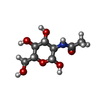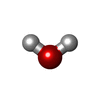+Search query
-Structure paper
| Title | Architecture, dynamics and biogenesis of GluA3 AMPA glutamate receptors. |
|---|---|
| Journal, issue, pages | Nature, Year 2025 |
| Publish date | Jul 1, 2025 |
 Authors Authors | Aditya Pokharna / Imogen Stockwell / Josip Ivica / Bishal Singh / Johannes Schwab / Carlos Vega-Gutiérrez / Beatriz Herguedas / Ondrej Cais / James M Krieger / Ingo H Greger /    |
| PubMed Abstract | AMPA-type glutamate receptors (AMPARs) mediate the majority of excitatory neurotransmission in the brain. Assembled from combinations of four core subunits, GluA1-4 and around 20 auxiliary subunits, ...AMPA-type glutamate receptors (AMPARs) mediate the majority of excitatory neurotransmission in the brain. Assembled from combinations of four core subunits, GluA1-4 and around 20 auxiliary subunits, their molecular diversity tunes information transfer and storage in a brain-circuit-specific manner. GluA3, a subtype strongly associated with disease, functions as both a fast-transmitting Ca-permeable AMPAR at sensory synapses, and as a Ca-impermeable receptor at cortical synapses. Here we present cryo-electron microscopy structures of the Ca-permeable GluA3 homomer, which substantially diverges from other AMPARs. The GluA3 extracellular domain tiers (N-terminal domain (NTD) and ligand-binding domain (LBD)) are closely coupled throughout gating states, creating interfaces that impact signalling and contain human disease-associated mutations. Central to this architecture is a stacking interaction between two arginine residues (Arg163) in the NTD dimer interface, trapping a unique NTD dimer conformation that enables close contacts with the LBD. Rupture of the Arg163 stack not only alters the structure and dynamics of the GluA3 extracellular region, but also increases receptor trafficking and the expression of GluA3 heteromers at the synapse. We further show that a mammalian-specific GluA3 trafficking checkpoint determines the conformational stability of the LBD tier. Thus, specific design features define communication and biogenesis of GluA3, offering a framework to examine this disease-associated glutamate receptor. |
 External links External links |  Nature / Nature /  PubMed:40592473 PubMed:40592473 |
| Methods | EM (single particle) |
| Resolution | 2.59 - 3.77 Å |
| Structure data | EMDB-52325, PDB-9hpc: EMDB-52326, PDB-9hpd: EMDB-52327: The NTD dimer and the interfacing LBD region of the AMPAR complex GluA3- TARP gamma2 in the apo state. EMDB-52328, PDB-9hpf: EMDB-52329, PDB-9hpg: EMDB-52332, PDB-9hpk: EMDB-53109, PDB-9qfh: |
| Chemicals |  ChemComp-NAG:  ChemComp-HOH: |
| Source |
|
 Keywords Keywords | MEMBRANE PROTEIN / AMPAR / ion channels / neurotransmission / ion channel / glutamate |
 Movie
Movie Controller
Controller Structure viewers
Structure viewers About Yorodumi Papers
About Yorodumi Papers


















